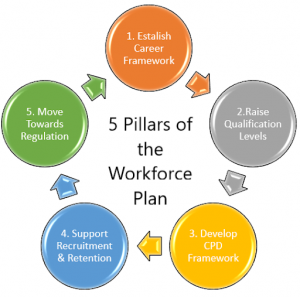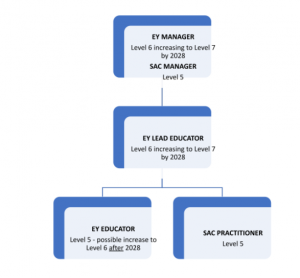On the 6th of December the DCEDIY published a new Workforce Plan for the ELC and SAC sector called “Nurturing Skills: The Workforce Plan for Early Learning and Care and School-Age Childcare 2022-2028”. The development of this plan was one of the targets previously outlined in the First Five strategy. Included in the new plan is an outline of various targets related to the sector which the DCEDIY aim to implement between 2022 and 2024. In this blog post we will look at some of the main points included in this new plan to see what impact it will have on educators and the sector as a whole over the next couple of years.
A Changing Landscape
There has been quite a lot of change over recent times in the ELC sector including the introduction of mandatory minimum qualifications in 2016, the publication of First Five in 2019 and the National Quality Guidelines for SAC in 2020. All of these developments are contributing to the, albeit slow, progression of the workforce towards professional status and recognition. More and more educators are engaging in degree studies to either level 7 or level 8 on the QQI framework with the numbers of those engaging in level 5 studies falling. It seems that educators want to study and earn degree qualifications in their field which aligns with the First Five goal to have a 50% degree led workforce by 2028. However, as with most other sectors which require the workforce to hold a degree, the ELC sector want and deserve professional recognition in return. Hopefully the steps outlined in the Nurturing Skills Workforce Plan will begin to pave the way.
So, what exactly does the Workforce Plan outline? Below are some of the main points.
Core Funding:
Government funding is set to increase, in line with promises made in First Five, from €4485m in 2018 to at least €970m by 2028. As announced in the budget earlier this year, a new Core Funding stream will come into effect from September 2022. This funding will target a number of areas including:
- Funding to support upskilling requirements for various roles and career progression – importantly, this funding will not be limited to those working in ECCE programmes and will extend to those working at all levels of ELC from birth upwards.
- Support for providers to improve terms and conditions.
- Improve conditions around non-contact time, planning, training and curriculum implementation.
- Funding to meet the cost of releasing staff to engage in training and CPD.
- September to December 2022 should see €69m in funding with a full years funding of €207 coming in 2023.
The 5 Pillars of the Workforce Plan:
The Workforce Plan has been organised under the 5 interlinked pillars which are briefly described below:

Pillar 1: Establish a Career Framework:
Currently, there are no agreed titles for the various positions in ELC. This is a major factor when it comes to professionalisation and professional recognition. To address this, the following role titles have been suggested in the Workforce Plan as universal titles within the sector:
- Early Years Educator – all ELC practitioners.
- Lead Educator – previously known as “Room Leader”.
- Manager – the person in charge of the setting.
- School Age Childcare Practitioner
This would mean that there will be consistency and clarity across the board in relation to role profiles and associated duties, job descriptions and pay expectations no matter which organisation you are working for throughout the country.
Pillar 2: Raising Qualification Levels:
When compared internationally, research has found that Ireland is unusual in that room leaders are not required to be degree qualified and managers are not required to meet any qualification requirement. The Workforce Plan states that no distinction will be made between roles and education requirements for educators working in ELC from birth to ECCE age, therefore a Lead Educator will be required to hold the same qualifications for working in a baby room or an ECCE room. The plan outlines the following changes in relation to updating qualification requirements at all levels and importantly, states that funding will be provided to facilitate upskilling where required:

Pillar 3: Develop a National CPD System:
A major issue for those working in the sector has been the lack of opportunities for career progression. The Workforce Plan has set out a career pathway to address this which will include Continuing Professional Development (CPD) requirements. Supports and requirements for CPD will be facilitated through:
- A centralised system for recording CPD undertaken.
- A review of Síolta.
- Development of a self-evaluation framework.
- Development of a suite of CPD resources.
- Funding to support release of staff to engage in CPD.
Pillar 4: Supporting Recruitment, Retention & Diversity:
Actions will be taken to promote careers in the ELC and SAC sector along with promotion of gender-balance and diversity.
Pillar 5: Moving Towards Regulation of the Sector:
The introduction of a single professional standards body, similar to the Teaching Council within the primary school sector, will be considered as part of the move to regulation and professionalisation.
Finally….are we on our way?
The DCEDIY hope that by implementing these measures, supported by Core Funding streams, issues such as staff recruitment and retention will be addressed and improved. It is also hoped that the knock-on effect will be that the sector will become more attractive to graduates who previously might be deterred due to low wages and the lack of career opportunities. When all of these measures come together, they should align to make ELC a more appealing career choice and underpin the quality of provision in the sector. Research has previously shown that higher qualified staff have a positive impact on quality ELC and ultimately this benefits outcomes for the children who are at the centre of everything that we do.
At long last, it seems as though it is not only those working within the sector who recognise the valuable role that high quality ELC and SAC play in society, finally it looks as though we are on a viable and tangible pathway towards professional status and recognition.
MOSAIC Digital Solutions for Early Education provides a range of time and cost saving solutions for early childhood services. The company flagship product is MOSAIC Educator which is used by educators to record and support children’s learning and development and capture records required for quality compliance. For more see www.mosaicearlyed.com and follow us on social media @mosaicearlyed




